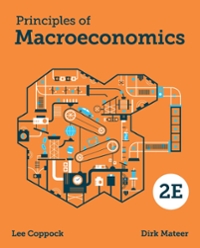Question
1.Because resources are scarce: a.we should not use them b.people must make choices among alternatives c.all human wants and desires can be satisfied d.resource prices
1.Because resources are scarce:
a.we should not use them
b.people must make choices among alternatives
c.all human wants and desires can be satisfied
d.resource prices are flexible
e.we must use them while we can
2.Suppose a student has an hour before their next class starts. They can either read a book, get
something to eat, or take a nap. The opportunity cost of getting something to eat is
a.the cost of what the student eats.
b.the value of reading and sleeping.c.
the loss of value from not reading or sleeping.d.
the net benefit of sleeping for another hour.
e.impossible to determine because the most preferred alternative is not known
3.Sugar and honey are viewed as substitutes for each other in many cooking applications. If the price
of sugar rises, we would expect:
a.the demand for honey to increase
b.the demand for honey to decrease
c.the quantity demanded of honey to decrease
d.the price of honey to decrease
e.the supply of honey to increase
4.In 1971, a pocket calculator cost more than $75. In 2010, a calculator of the same quality cost less
than $10. Which of the following explanations is most consistent with these facts?
a.An increase in the demand for calculators forced their price down.
b.A change in technology caused the supply curve for calculators to shift to the right, depressing
price.
c.As the population grew, fewer expensive calculators were needed, causing their price to fall.
d.Intense competition in the production of calculators caused the supply curve for calculators to
shift to the left, depressing price.
e.Growing incomes of consumers reduced the demand for calculators because they are a normal
good.
5.If the market for beef cattle was initially in equilibrium, an increase in the price of the feed grains
used to fatten cattle would cause:
a.the demand for beef cattle to increase, driving prices upward.
b.the supply of beef cattle to decrease, driving beef prices upward in the long run.
c.the supply of beef to increase, placing downward pressure on beef prices in the long run.
d.both supply and demand to fall, leaving price virtually unchanged.
e.the supply of beef to decrease, which then will cause demand to decrease, which means the effect
on the price of beef in uncertain.
6.The producer surplus for an individual unit of output sold can be found by:
a.subtracting marginal cost from the selling price.
b.subtracting total cost from the selling price.
c.subtracting average cost from the selling price.
d.subtracting selling price from the marginal cost.
e.adding the marginal cost and the selling price.
7.Suppose there are only two goods: apples and oranges. What happens if the price of each good
increases by 15 per cent?
a.The consumer will substitute apples for oranges.
b.The consumer will substitute oranges for apples.
c.There is no substitution effect because relative prices have remained constant.
d.Demand for both goods increases.
e.Demand for both goods decreases.
8.If a country is an importer of a particular good, this means that the world price is:
a.Above what the domestic equilibrium price is.
b.Below what the equilibrium price is.
c.Equal to the domestic equilibrium price.
d.Not known for certainty without more information.
e.Irrelevant to the question of international trade.
9.An argument for imposing tariffs on imported goods might be:
a.A new industry requires initial protection from established exporters.
b.Jobs will be destroyed without a tariff.
c.Other countries impose tariffs on our goods, so we need to reciprocate.
d.The domestic industry is necessary for national security purposes.
e.All of the above may be valid arguments.

Step by Step Solution
There are 3 Steps involved in it
Step: 1

Get Instant Access to Expert-Tailored Solutions
See step-by-step solutions with expert insights and AI powered tools for academic success
Step: 2

Step: 3

Ace Your Homework with AI
Get the answers you need in no time with our AI-driven, step-by-step assistance
Get Started


